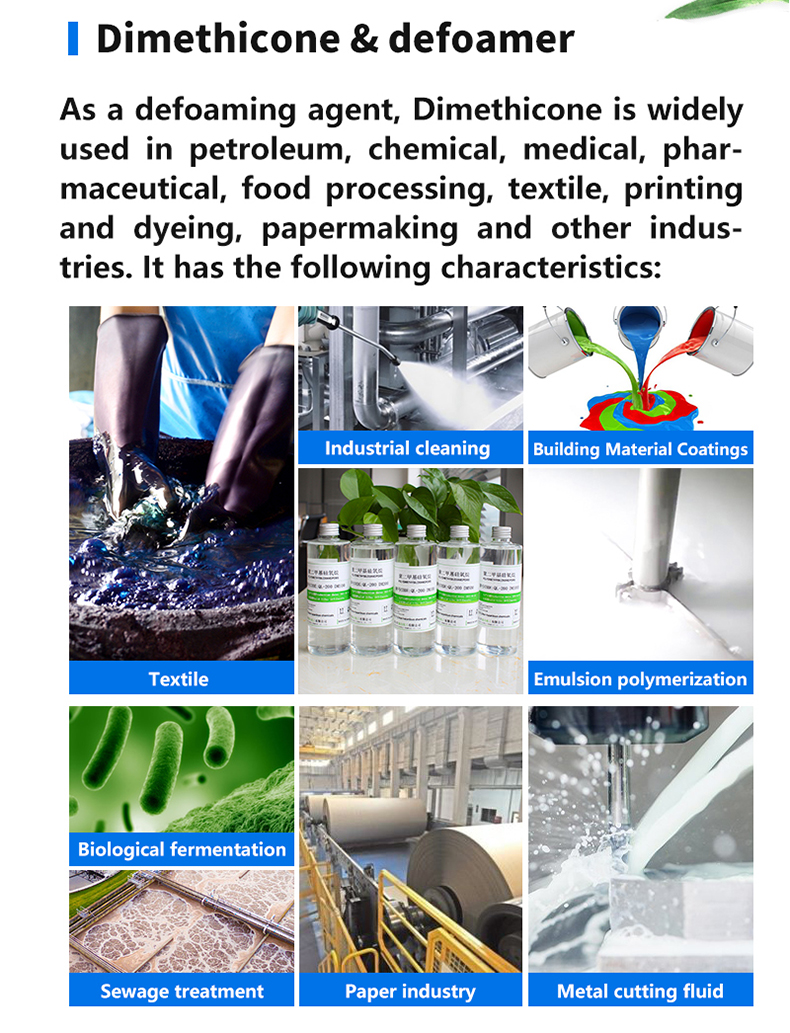Foam is a dispersion system in which a large number of bubbles are dispersed in a liquid, the dispersed phase is gas, and the continuous phase is liquid. Since the relative density of the bubbles is lower than that of the liquid, the bubbles in the liquid will rise to the liquid surface, forming an aggregate of bubbles separated by a liquid film composed of a small amount of liquid, that is, foam. Foam is a thermodynamically unstable system, and the factors affecting its stability include the surface tension of the liquid, the properties of the interface film, the repairing effect of the surface tension, the surface charge, the diffusion of the foam gas and the structure of the added surfactant, etc.

When a surfactant is added to the solution system, a layer of surface active agent molecules is adsorbed on the surface of the bubbles, and when it reaches a certain concentration, the bubbles form a solid film. The surfactant adsorbs on the gas-liquid interface, resulting in a decrease in the surface tension of the liquid surface, thereby increasing the gas-liquid contact surface. This makes it difficult for the bubbles to coalesce. When the bubbles rise through the liquid surface, they will adsorb a layer of surfactant molecules on the liquid surface. Therefore, the bubble film exposed to the air, adsorbed with surfactant is not the same as the bubble film in the solution. It contains two layers of surfactant molecules to form a bimolecular film, and the adsorbed surfactant has a protective effect on the liquid film. The function of the defoamer is to destroy and inhibit the formation of the bimolecular film. The surface tension of the defoamer is low, and it is easy to spread on the surface of the solution. After entering the bubble liquid film, it replaces the surface active molecules on the original liquid film surface. Reduces the surface tension at the point of contact. Due to the high surface tension of the foam liquid film, it will shrink, so that the liquid film with low surface tension will be pulled and stretched around, forming a film with poor strength, which will gradually become thinner, unable to generate effective elastic contraction force and lose self-repair. effect. The viscosity is also reduced, the liquid discharge rate of the foam liquid film and the diffusion rate of the gas are accelerated, the life of the foam is shortened, and finally the rupture is eliminated. In short, the addition of defoamer can increase the surface tension of the foam liquid film in the solution system, lose its self-healing effect, reduce the viscosity, and finally lead to the destruction of the mechanical balance of the liquid film and the rupture of the foam to achieve the purpose of defoaming.
Defoaming is the reverse process of foam stabilization. Silicone defoamers generally achieve the purpose of eliminating foam by two functions. One is that silicone defoamers have very low surface tension. It has good spreading performance on the foam liquid film. It can spread quickly on the surface of the foam. During the process of diffusion and expansion, the stabilizing surfactant molecules on the surface of the foam liquid film are expelled, and the local surface tension of the foam wall is reduced. Destroys the "self-healing" effect of the bubble. Breaks the foam; another effect is that when the silicone defoamer is dispersed in the foaming liquid, it may insert into the foam liquid wall, but only to a very limited extent, forming a mixed monolayer liquid film with the foaming agent, However, the cohesion of the mixed liquid film is not good. The local viscosity drops, also causing the foam to burst.
At present, there are many varieties and models of commercial silicone antifoams at home and abroad, with different properties. Generally, they can be divided into oil (ointment) type, solution type, emulsion type, solid type and modified silicone oil type.
2.1 Oil (ointment) type defoamer
Oil type defoamer is to use silicone oil directly as defoamer. It is mainly used in oil-phase foaming systems that do not allow the presence of dispersants and emulsifiers. It is generally believed that silicone oils of different viscosities. It shows different defoaming effects for the same foaming system. The low-viscosity silicone oil-based defoamer has a fast defoaming effect, but has poor sustainability, while the high-viscosity silicone oil-based defoamer has a slow defoaming effect, but good sustainability. Ointment-type defoamer is an ointment-shaped defoamer prepared by adding silicon dioxide, aluminum oxide and other micropowders to silicone oil. It is mainly used for defoaming of non-aqueous systems.
The defoaming effect of dimethyl silicone oil depends on the degree of dispersion of the silicone oil in the foaming system. The defoaming effect of the silicone oil is only when the silicone oil is dispersed below 100 m, and the dispersion system is stable when the dispersion is below 20 m. In order to improve the degree of dispersion, mechanical stirring, such as high-speed stirring under heating, can be used, or a homogeneous dispersion of silicone oil and mineral oil can be prepared in advance with a colloid mill. Or make silicone oil and white carbon black and other micropowders into an ointment type defoamer in advance, and use it with the help of the dispersion of white carbon black and other micropowders.
2.2 Solution type defoamer
Silicone solution type defoamer can be prepared by dissolving dimethyl silicone oil in a suitable solvent. Use organic silicon defoamer prepared from organic solvents such as polychloroethane, toluene and xylene. It can be used for defoaming operation of oil-soluble medium; and the organic silicon defoaming agent prepared from water-soluble organic solvents such as hexylene glycol and glycerin is selected. Can be used for defoaming of aqueous solutions. The preparation process of solution type silicone defoamer is very simple. Easy to use. The silicone oil is dispersed in the foaming liquid with the help of organic solvent to defoam. At the same time, some solvents will also play a certain defoaming effect during the diffusion process. However, this method has not been widely used, mainly because large-scale use will increase the cost of defoaming agents and may cause environmental pollution.
2.3 Emulsion type defoamer
The silicone oil or silicone paste is made into silicone oil emulsion under the action of strong stirring or emulsifier, which can effectively improve the dispersibility of silicone oil in the water phase. Therefore, it is widely used as a defoamer in water systems. Emulsion-type defoamer is also the most widely used and most widely used defoamer of silicone defoamer.
Emulsion-type silicone defoamer is generally prepared from dimethyl silicone oil, emulsifier, emulsion stabilizer and deionized water. The emulsifiers used are mainly non-ionic emulsifiers with low foaming properties, such as Span, Tween and polyethylene glycol. The effect of using a mixed emulsifier is better than that of a single emulsifier. The particle size of silicone oil emulsion is the most important control index for emulsion type silicone defoamer. In order to obtain a silicone oil emulsion with high defoaming efficiency and good storage stability, the particle size is usually required to be less than 10 μm.
Therefore, in addition to selecting suitable emulsifiers and mixing and grinding process conditions, thickeners such as polyvinyl alcohol and methyl cellulose can also be added to increase the viscosity of the continuous phase.
When using emulsion type silicone defoamer. The temperature, acidity and alkalinity of the foaming system should be understood first, because they will affect the stability of the emulsion and even lead to demulsification.
Although the emulsion type silicone defoamer has the disadvantages of being difficult to store for a long time, easy to delaminate and easy to deteriorate, it has the characteristics of convenient use, wide application, obvious defoaming effect and moderate price. With the advancement of technology, emulsion-type silicone defoamer will still have a large space for development.
2.4 Solid type defoamer
Solid silicone defoamer has the characteristics of good storage stability, easy transportation, and convenient use.
There are three preparation methods of solid silicone defoamer: (1) Disperse silicone oil directly on the surface of solid carrier; (2) Mix silicone oil with fatty alcohols, fatty acids, fatty amides, fatty acid esters with a lower softening point Or paraffin and other substances are melted together, and then the melt is attached to the surface of the solid carrier; (3) The silicone oil is mixed with the film-forming substance, so that the film-forming substance is encapsulated outside the silicone oil defoaming component to form dispersed solid particles.
2.5 Modified silicone oil type defoamer
Modified silicone oil introduces methyl silicone oil with some hydrophilic polyether segments, which can be turned into a self-emulsifying defoamer, maintains dispersibility in the foaming system for a long time, and prolongs the service life of the defoamer. The commonly used modified silicone oils currently used as defoaming agents include polyether silicone oil, fluorocarbon-based silicone oil and long-chain alkyl silicone oil, and their applications and effects are eye-catching.
End group, side group and branched polyether silicone oil can be used as defoamer. They all have a clear cloud point, and only above the cloud point have strong defoaming properties. Below the cloud point, it promotes foaming. In addition, using the strong emulsifying ability of polyether silicone oil and compounding with silicone paste, it can self-emulsify into a stable and efficient defoamer in the water system. It has been widely used for high-temperature dyeing of polyester fibers, various lubricating oils, cutting Defoaming of oil, antifreeze and strong acid systems.
Long-chain alkyl silicone oil defoamer can be used in fields such as fermentation, food addition, medical treatment, textile, petroleum, synthetic rubber and resin, coating and ink. Due to its good affinity for organic materials, long-chain alkyl silicone oil defoamer will not affect the post-processing properties of the product. However, the surface tension increases with the increase of carbon chain, and the defoaming performance decreases accordingly, so it is very important to choose the appropriate carbon chain length. Long-chain alkyl silicone oils are used in defoaming of both non-aqueous and aqueous systems.
The surface tension of fluorocarbon-based silicone oil is lower than that of other silicone oils, so the defoamer formulated from it is more effective in reducing the surface tension of various foaming systems, and the effect is better than other silicone oil defoamer. Mainly used for the foaming medium of non-aqueous systems with strong solubility to methyl silicone oil or methyl phenyl silicone oil, such as aliphatic hydrocarbons, aromatic hydrocarbons and naphtha.
3. Conclusion
Silicone defoamer not only has good defoaming and anti-foaming effects, but also has the characteristics of low dosage, good chemical inertness, and can function under harsh conditions. In recent years, it has developed rapidly, and new varieties and models suitable for different environments are used. Continue to produce. The application area is also constantly expanding. In the future, new high-efficiency silicone defoamers with strong applicability and can further improve product quality and equipment utilization will be further developed, especially polyether-modified silicone defoamer and emulsion type defoamer with excellent performance. The market occupies a dominant position.




